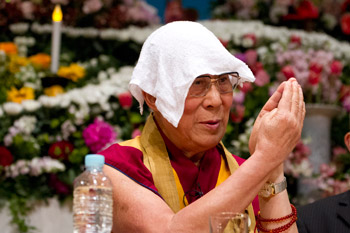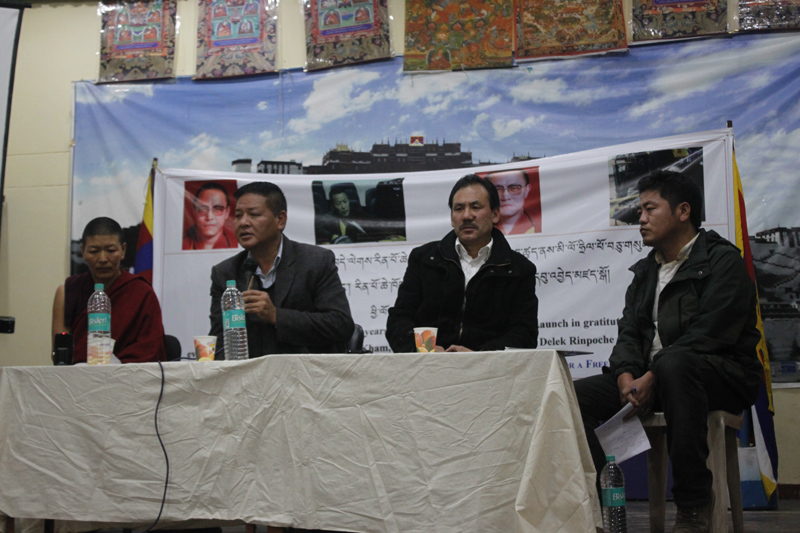An Interview and a Teaching for the All Japan Soto Young Priests Association
[dalailama.com] Gifu, Japan, April 8, 2015: In addition to several private audiences this morning, His Holiness the Dalai Lama gave an interview to Japanese journalists, Tetsuo Kogure and Kentaro Isomura of the Asahi Shimbun newspaper and Maki Osanai of Live Viewing Japan. They began by recalling that in the more than 25 years since His Holiness received the Nobel Peace Prize, terrorism has spread. They asked him how he sees the situation. He replied:
“After the fall of the Berlin Wall, the Soviet Union collapsed and the Warsaw Pact dissolved. Several former members of the Warsaw Pact emerged as democratic states. The nuclear threat subsided, as a result of which the world became safer. It’s true that there have been severe terrorist incidents, but even they are mild in comparison to a nuclear exchange. One of the saddest aspects is that terrorism has become linked to religious faith. We need to redouble our efforts to reach out to the people involved. All religions have provided solace for millions of people in the past and they will continue to do so. We have to accept that in the wider world there are several religions and several truths.
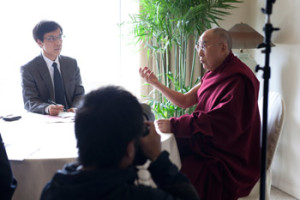
“After the September 11th event, I wrote to President Bush to express my condolences, but I also said ‘I hope you can deal with the consequences of this in a non-violent way’. My concern was that in a situation in which there was already one Bin Laden, to use force risked creating 10 Bin Ladens or 100 Bin Ladens. The trouble is that the use of violence provokes a violent response. We have to remember that terrorists are human beings too and find a way to talk to them.”
The journalists pointed out that it can be very difficult to open such a dialogue. His Holiness agreed, but persisted in saying that although it is possible that some hardliners would be unmoved, others would very likely respond to appropriate overtures from appropriate parties. He mentioned Muslims he has met in Jordan who are well educated and have knowledge of the world at large and Indian Muslims who are familiar with living in a multi-religious society who might exert a positive influence over their fellow Muslims.
“That is the only way to resolve this. Just dropping more bombs won’t do it.”
The journalists asked His Holiness about how to find a balance between freedom of speech and freedom of religion. He replied that freedom does not mean you can just kill people. He repeated what he has reported before that Muslim friends have told him, which is that when a Muslim initiates bloodshed he ceases to be a proper Muslim. Similarly, his friends have clarified that the word Jihad is often misunderstood. It is not about harming other people, the struggle it refers to is a struggle with our disturbing emotions. And from that point of view, all religious traditions engage in Jihad.
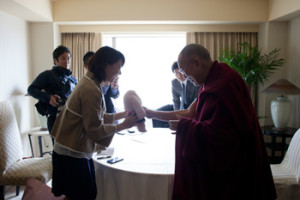
“Freedom of speech is important, but it should be exercised in a positive way. Such freedom is based on the understanding that human nature is essentially gentle and that human beings possess intelligence that can be used constructively.”
With regard to independent intervention in violent and potentially violent crises His Holiness mentioned that when the Iraq crisis was unfolding there was talk of Nobel Peace Laureates going to Bagdad to approach Saddam Hussein. Their opening would have been that Hussein did not want to die, nor would he have wanted the invasion of his country. His Holiness suggested that it is still possible for a group of Peace Laureates to go to Syria to meet the two sides and ask,
“What do you really want to achieve? Do you really have faith in Islam? Have you no concern for Islam’s reputation?”
There are conflicts elsewhere that also might respond to mediation. His Holiness mentioned the Buddhist-Muslim conflicts in Burma and his appeal to Buddhists there, when they find themselves in confrontation, to visualise the face of the Buddha. He restated his conviction that if the Buddha were present in that situation he would offer protection to the Muslims under attack.
The journalists asked about prospects for dialogue between the Central Tibetan Administration (CTA) and the Chinese authorities. His Holiness replied that direct contact opened in 1979 and had been resumed in 1993, but so far had produced no concrete results. He said that hardliners among the communist authorities persist in asserting that Tibetans are ‘splittists’ intent on separating Tibet from China, when the world knows that they are not seeking independence. He remarked that Xi Jinping seems to be more realistic and to be sincere in his efforts to tackle corruption. In the meantime, support for Tibetans among ordinary Chinese seems to be growing.
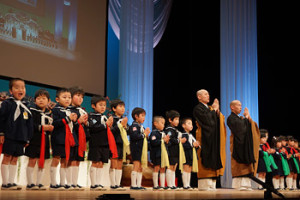
After lunch, His Holiness walked from his hotel to the Nagarakawa Convention Centre Hall where he had been invited to speak as part of the 40th anniversary celebrations of the All Japan Soto Young Priest Association (AJSYPA). Events began with a striking video focusing on the friendship between His Holiness and the Soto Zen tradition. Very young children performed a charming song and dance and Soto priests paid formal respects to the Buddha before His Holiness joined them on the stage.
In his address he said that it is now more than 2600 years since the time of the Buddha and his teaching continues to flourish in countries like Japan. Meanwhile today there is growing interest in non-Buddhist countries in what Buddhism has to teach about the mind. He said that since Buddhism and other religious traditions contribute to human welfare we should have respect for all of them.
“A unique factor of the Buddha’s teaching is the notion of dependent origination, but that doesn’t mean to say that Buddhism is better than other traditions, because whether or not this or that tradition is suitable depends on the person’s disposition. The Buddha himself gave differing teachings on differing occasion because of the varied dispositions of his listeners. He explained in some cases that there is no independently existing self, while in others he taught that the five psycho-physical aggregates are like a burden and the person is the carrier, suggesting that there is. The common message of all these religious traditions is love, compassion and contentment.
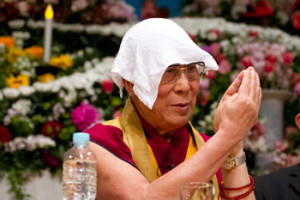
Photo/Tenzin Jigmey
“The basic Buddhist teaching of the Four Noble Truths and the 37 Factors of Enlightenment is common to both Pali and Sanskrit traditions. The Perfection of Wisdom teachings were part of the second turning of the wheel of Dharma. They require us to analyse and investigate to develop wisdom. This involved the basis, path and result. The basis is to establish an acquaintance with wisdom. On the path we enhance it through meditation and as a result we realize enlightenment. “
His Holiness emphasised that analysis and investigation, the use of logic, are among the most important features of the Nalanda tradition and in this there is a correspondence to a modern scientific approach. It is on this basis that a regular dialogue has developed with modern scientists and study of science has been introduced in Tibetan monasteries. He remarked that that modern quantum theory has a lot in common with the Madhyamaka philosophical view.
He explained that the Buddhist approach to wisdom involves hearing, thinking and meditation. We learn the instruction by hearing or reading about it. We deepen our understanding by thinking about it and then by familiarizing ourselves with that understanding in meditation, we develop insight. He related this to the three higher trainings. The higher training in ethics involves precepts and discipline. In meditation it entails single pointed concentration and in wisdom it entails the development of special insight.
When, in the Heart Sutra mantra, the Buddha says, ‘Tadyata gate gate paragate parasamgate bodhi svaha (‘It is thus: Proceed, proceed, proceed beyond,
thoroughly proceed beyond, be founded in enlightenment),’ he is telling his followers to proceed through the five paths:
gate—the path of accumulation;
gate—the path of preparation;
paragate—the path of seeing;
parasamgate—the path of meditation;
bodhi svaha—the path of no more learning.
Several prepared questions were then put to His Holiness. Two very small children asked why we fold our hands together and he told them it was to show respect. He added that there are two ways to hold your hands. The ordinary way is to hold them flat together, but the Buddhist way is to tuck the thumbs in as if you are holding a jewel. The outer shape of the hands like this represents the form body of the Buddha, whereas the empty space between them represents the truth body.

Another little girl asked him where he wanted to be reborn and he answered by quoting his favourite verse from ‘Guide to the Bodhisattva’s Way of Life’:
For as long as space endures
And for as long as living beings remain,
Until then may I too abide
To dispel the misery of the world.
When a young man who has spent time in Bhutan asked about happiness, His Holiness drew a distinction between sensory happiness and mental happiness, saying that the latter can be gained by training the mind. A young mother with a child in her arms asked what is most important to remember when raising children. His Holiness’s immediate response was to say he didn’t know, but then said:
“Show them affection.”
A funeral director wanted to know what we can do to help the dead and His Holiness told him:
“Since we Buddhists don’t believe in a creator god, what happens to us is in our own hands. If the deceased did good works, he or she will take a good rebirth. The Buddha said, ‘You are your own master’ and he meant that our destiny is up to us and what we do. If the person who has died is a member of your family, you can make offerings on their behalf. If he or she was one of your parents, you can perform meritorious actions for them. And if he or she was your teacher you can make prayers for them. How you then conduct the funeral ceremony doesn’t really matter.”
A woman who sells the altars Japanese preserve in memory of the dead asked His Holiness what is the most important teaching for him. He answered:
“The awakening mind of bodhichitta and understanding emptiness. Understanding emptiness through meditation gives rise to the truth body that is of benefit to us, whereas cultivating the awakening mind of bodhichitta gives rise to the form body that is of benefit to others. These are the fruits of the practice of method and wisdom, which should be conducted in the context of an understanding of the two truths. As Nagarjuna’s ‘Precious Garland’ says:
‘If you and the world wish to attain
Unparalleled enlightenment,
‘Its roots are the altruistic aspiration to enlightenment
Firm like the king of mountains,
Compassion reaching to all quarters,
And wisdom not relying on duality.’
The occasion was brought to a close with a women’s choir chanting ‘Om mani padme hum’ in a style like plainsong, as paper leaves fell from the eves. The Ven Miyazaki, Chairman of AJSPYA, presented His Holiness with a classic traditional Japanese umbrella and he left the hall to warm applause.

